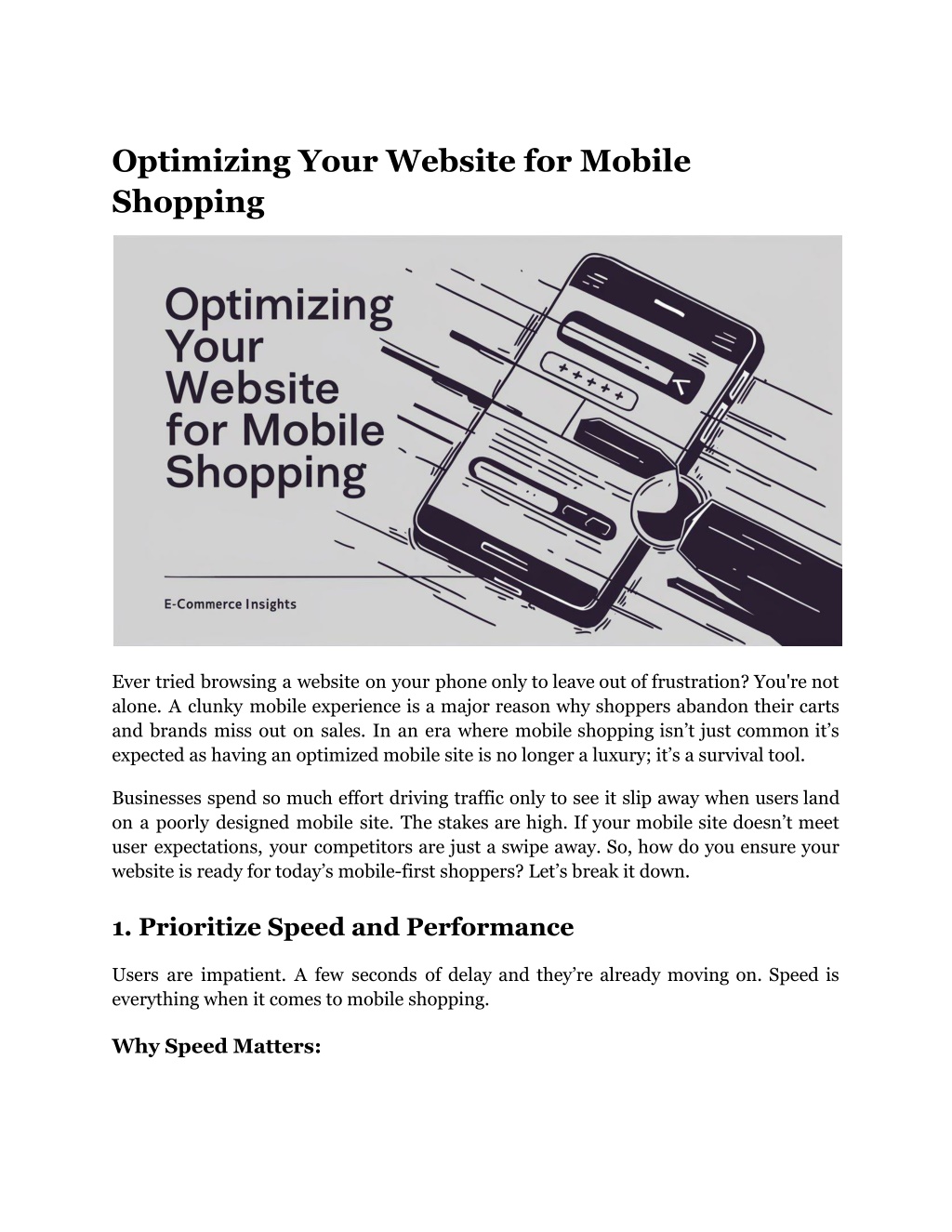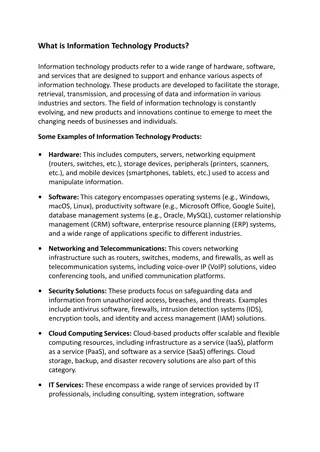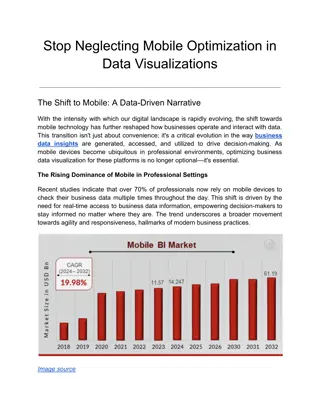
Optimizing Your Website for Mobile Shopping
Learn practical ways to leverage influencer marketing and drive sales for your business. Simple strategies for real results!
Download Presentation

Please find below an Image/Link to download the presentation.
The content on the website is provided AS IS for your information and personal use only. It may not be sold, licensed, or shared on other websites without obtaining consent from the author. Download presentation by click this link. If you encounter any issues during the download, it is possible that the publisher has removed the file from their server.
E N D
Presentation Transcript
Optimizing Your Website for Mobile Shopping Ever tried browsing a website on your phone only to leave out of frustration? You're not alone. A clunky mobile experience is a major reason why shoppers abandon their carts and brands miss out on sales. In an era where mobile shopping isn t just common it s expected as having an optimized mobile site is no longer a luxury; it s a survival tool. Businesses spend so much effort driving traffic only to see it slip away when users land on a poorly designed mobile site. The stakes are high. If your mobile site doesn t meet user expectations, your competitors are just a swipe away. So, how do you ensure your website is ready for today s mobile-first shoppers? Let s break it down. 1. Prioritize Speed and Performance Users are impatient. A few seconds of delay and they re already moving on. Speed is everything when it comes to mobile shopping. Why Speed Matters:
High Bounce Rates: 53% of users leave a mobile page if it takes longer than 3 seconds to load. SEO Impact: Search engines prioritize faster sites, meaning your slow site could be hidden behind the pages of competitors. User Satisfaction: Smooth, fast-loading pages keep users engaged and reduce frustration. Quick Fixes for Better Speed: Compress Images: Use formats like WebP to maintain quality with smaller file sizes. Minimize JavaScript: Too many scripts slow down your site; trim the unnecessary ones. Enable Browser Caching: This helps returning users load your site faster. 2. Make Navigation Intuitive A visitor s journey through your site should be effortless. Mobile screens are small, so clutter and complex menus are your worst enemies. Tips for Better Navigation: Sticky Menus: A fixed menu helps users access important sections without scrolling up and down. Clickable Buttons: Ensure buttons are big enough to be easily tapped without accidental clicks. Short Menus: Keep options straightforward. If your menu feels like a maze, users will bail out fast. Table: Good vs. Poor Mobile Navigation Aspect Good Navigation Poor Navigation Menu Design Simple, collapsible Overloaded with links Buttons Large, tappable Small, hard-to-click Scroll Minimal scroll vertical Endless required scrolling
3. Optimize for Mobile SEO Optimizing your site for mobile isn t just about looks; it s about being discoverable. Mobile SEO ensures that your site appears when users search for products or services on their phones. Key Mobile SEO Tactics: Responsive Design: Your site should adapt seamlessly to any screen size. Local SEO: Optimize for location-based keywords, especially if you re targeting regional customers. Structured Data: Make use of schema markup to help search engines understand your site s content better. Working with a professional SEO agency in Lahore or your area can help fine-tune these elements for greater impact. 4. Streamline the Checkout Process You ve done the hard work of getting a shopper to add items to their cart. The last thing you want is to lose them at checkout. A complicated or slow checkout is one of the top reasons users abandon their carts. How to Simplify Checkout: One-Page Checkout: Condense the process into one page, eliminating endless forms. Guest Checkout: Not everyone wants to create an account. Allow for guest checkouts to speed things up. Auto-Fill Options: Integrate auto-fill for payment and address details to save time. Reminder: Security matters. Use trusted payment gateways and display clear indicators of security to boost shopper confidence. 5. Optimize Visuals for Mobile High-resolution visuals are essential, but they can tank your page speed if not managed right. The key is to find balance.
Tips for Image Optimization: Responsive Images: Use media queries to load different image sizes based on the device. Lazy Loading: Load images as users scroll to reduce initial load times. Alternative Text: Always add alt text for better accessibility and SEO benefits. 6. Focus on Mobile UX (User Experience) Designing for mobile UX means thinking about how users interact with your site in real life. A desktop site adapted for mobile is not the same as a site designed with mobile in mind. Mobile UX Essentials: Readable Fonts: Avoid tiny fonts. Mobile users shouldn t need to pinch and zoom to read. No Pop-Ups: Pop-ups are annoying, especially on mobile. They disrupt the experience and can lead to higher bounce rates. Seamless Transitions: Avoid abrupt transitions that make navigation feel clunky. 7. Utilize Mobile-Friendly Features Mobile has capabilities that desktops don t, and using these to your advantage can enhance user experience and drive sales. Effective Mobile Features: Click-to-Call Buttons: Perfect for service-based businesses where users might want immediate contact. Location Services: Tailor content or offers based on the user s location. Push Notifications: When used wisely, these can remind users of sales or abandoned carts without being intrusive. 8. Regularly Test and Update The digital landscape is constantly evolving. What worked six months ago might not cut it today. Regular testing ensures your mobile site is always performing at its best. Testing Tools to Consider:
Googles Mobile-Friendly Test: A simple tool that checks your sites mobile performance. PageSpeed Insights: Provides insights into what s slowing down your mobile pages. Heatmaps: Tools like Hotjar show where users are clicking and scrolling the most. Keep in Mind: User feedback is gold. If users are bouncing or expressing frustration, listen and adapt. Conclusion Optimizing your site for mobile shopping is not just a nice-to-have; it s an absolute must. With more and more users turning to their phones to browse and buy, providing a seamless mobile experience will make or break your brand s success. By focusing on speed, intuitive navigation, mobile SEO, and user-centric features, you ll not only keep users engaged but also convert them into loyal customers. And remember, if you need a comprehensive strategy, partnering with an SEO agency in Lahore or a reputable local service can be the game-changer your business needs to stay competitive. The road to mobile optimization is ongoing, but the payoff is better engagement, more sales, and stronger customer loyalty. Site Article: Optimizing Your Website for Mobile Shopping






















